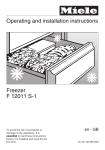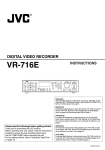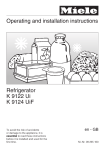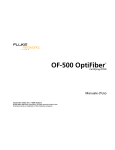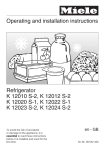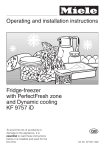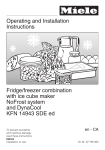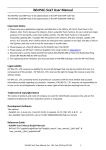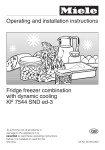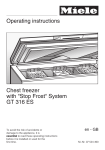Download Miele GT5284 S freezer
Transcript
Operating instructions Chest freezer with "Stop Frost" system GT 5xx2 S GT 5xx4 S GT 5xx6 S To avoid the risk of accidents or damage to the appliance, it is essential to read these instructions before it is installed and used for the first time. en - GB, IE M.-Nr. 09 021 210 Contents Guide to the appliance . . . . . . . . . . . . . . . . . . . . . . . . . . . . . . . . . . . . . . . . . . . . . 4 Caring for the environment . . . . . . . . . . . . . . . . . . . . . . . . . . . . . . . . . . . . . . . . . . 6 Warning and Safety instructions . . . . . . . . . . . . . . . . . . . . . . . . . . . . . . . . . . . . . 7 How to save energy . . . . . . . . . . . . . . . . . . . . . . . . . . . . . . . . . . . . . . . . . . . . . . . 12 Switching on and off . . . . . . . . . . . . . . . . . . . . . . . . . . . . . . . . . . . . . . . . . . . . . . 13 Switching off for longer periods of time . . . . . . . . . . . . . . . . . . . . . . . . . . . . . . . . . 14 The correct temperature . . . . . . . . . . . . . . . . . . . . . . . . . . . . . . . . . . . . . . . . . . . 15 Setting the temperature . . . . . . . . . . . . . . . . . . . . . . . . . . . . . . . . . . . . . . . . . . . . . 15 Temperature alarm. . . . . . . . . . . . . . . . . . . . . . . . . . . . . . . . . . . . . . . . . . . . . . . . 17 Activating the alarm system. . . . . . . . . . . . . . . . . . . . . . . . . . . . . . . . . . . . . . . . . . 17 Super freeze . . . . . . . . . . . . . . . . . . . . . . . . . . . . . . . . . . . . . . . . . . . . . . . . . . . . . 18 Super freeze . . . . . . . . . . . . . . . . . . . . . . . . . . . . . . . . . . . . . . . . . . . . . . . . . . . . . 18 Interior. . . . . . . . . . . . . . . . . . . . . . . . . . . . . . . . . . . . . . . . . . . . . . . . . . . . . . . . . . 19 Baskets . . . . . . . . . . . . . . . . . . . . . . . . . . . . . . . . . . . . . . . . . . . . . . . . . . . . . . . . . 19 Separate freezing section . . . . . . . . . . . . . . . . . . . . . . . . . . . . . . . . . . . . . . . . . . . 20 Freezing and storing food . . . . . . . . . . . . . . . . . . . . . . . . . . . . . . . . . . . . . . . . . . 21 Maximum freezing capacity. . . . . . . . . . . . . . . . . . . . . . . . . . . . . . . . . . . . . . . . . . 21 Freezing fresh food . . . . . . . . . . . . . . . . . . . . . . . . . . . . . . . . . . . . . . . . . . . . . . . . 21 Storing frozen food . . . . . . . . . . . . . . . . . . . . . . . . . . . . . . . . . . . . . . . . . . . . . . . . 21 Home freezing . . . . . . . . . . . . . . . . . . . . . . . . . . . . . . . . . . . . . . . . . . . . . . . . . . . . 22 Hints on home freezing. . . . . . . . . . . . . . . . . . . . . . . . . . . . . . . . . . . . . . . . . . . 22 Packing . . . . . . . . . . . . . . . . . . . . . . . . . . . . . . . . . . . . . . . . . . . . . . . . . . . . . . 22 Before placing food in the freezer . . . . . . . . . . . . . . . . . . . . . . . . . . . . . . . . . . 23 Placing food in the freezer . . . . . . . . . . . . . . . . . . . . . . . . . . . . . . . . . . . . . . . . 23 Defrosting . . . . . . . . . . . . . . . . . . . . . . . . . . . . . . . . . . . . . . . . . . . . . . . . . . . . . . . 23 Cooling drinks . . . . . . . . . . . . . . . . . . . . . . . . . . . . . . . . . . . . . . . . . . . . . . . . . . . . 24 Freezer tray . . . . . . . . . . . . . . . . . . . . . . . . . . . . . . . . . . . . . . . . . . . . . . . . . . . . . . 24 Cool pack. . . . . . . . . . . . . . . . . . . . . . . . . . . . . . . . . . . . . . . . . . . . . . . . . . . . . . . . 24 Defrosting . . . . . . . . . . . . . . . . . . . . . . . . . . . . . . . . . . . . . . . . . . . . . . . . . . . . . . . 25 "Stop Frost" system . . . . . . . . . . . . . . . . . . . . . . . . . . . . . . . . . . . . . . . . . . . . . . . . 25 Cleaning and care . . . . . . . . . . . . . . . . . . . . . . . . . . . . . . . . . . . . . . . . . . . . . . . . 27 Cleaning the outer casing, the interior and accessories . . . . . . . . . . . . . . . . . . . . 27 Ventilation gap . . . . . . . . . . . . . . . . . . . . . . . . . . . . . . . . . . . . . . . . . . . . . . . . . . . . 27 Freezer lid seal . . . . . . . . . . . . . . . . . . . . . . . . . . . . . . . . . . . . . . . . . . . . . . . . . . . 27 2 Contents Problem solving guide . . . . . . . . . . . . . . . . . . . . . . . . . . . . . . . . . . . . . . . . . . . . 29 Noises . . . . . . . . . . . . . . . . . . . . . . . . . . . . . . . . . . . . . . . . . . . . . . . . . . . . . . . . . 31 After sales service . . . . . . . . . . . . . . . . . . . . . . . . . . . . . . . . . . . . . . . . . . . . . . . . 32 Electrical connection . . . . . . . . . . . . . . . . . . . . . . . . . . . . . . . . . . . . . . . . . . . . . . 33 Installation . . . . . . . . . . . . . . . . . . . . . . . . . . . . . . . . . . . . . . . . . . . . . . . . . . . . . . 34 Location . . . . . . . . . . . . . . . . . . . . . . . . . . . . . . . . . . . . . . . . . . . . . . . . . . . . . . . . . 34 Climate range . . . . . . . . . . . . . . . . . . . . . . . . . . . . . . . . . . . . . . . . . . . . . . . . . . 34 Ventilation . . . . . . . . . . . . . . . . . . . . . . . . . . . . . . . . . . . . . . . . . . . . . . . . . . . . . . . 35 Appliance Dimensions . . . . . . . . . . . . . . . . . . . . . . . . . . . . . . . . . . . . . . . . . . . . . . 36 3 Guide to the appliance a In-operation indicator light b Alarm indicator light c Super freeze button with indicator light d On/Off and temperature selector e Control panel integrated in the handle h Ventilation gap i Defrosting outlet f Interior lighting g Lock * * depending on model 4 Guide to the appliance Lock (depending on model) The lock is fitted with a safety mechanism: ^ Press and hold the a button. ^ Turn the key 90°clockwise. The freezer is now locked. To unlock the freezer, turn the key 90° anti-clockwise. 5 Caring for the environment Disposal of the packing material The transport and protective packing has been selected from materials which are environmentally friendly for disposal, and should be recycled. Ensure that any plastic wrappings, bags etc. are disposed of safely and kept out of the reach of babies and young children. Danger of suffocation! Disposal of your old appliance Electrical and electronic appliances often contain materials which, if handled or disposed of incorrectly, could be potentially hazardous to human health and to the environment. They are, however, essential for the correct functioning of your appliance. Please do not therefore dispose of it with your household waste. Please dispose of it at your local community waste collection / recycling centre or contact your dealer for advice. Ensure that it presents no danger to children while being stored for disposal. Take care not to damage the pipework at the back of it before or during transportation to an authorised collection depot. In this way, refrigerant in the pipework and oil in the compressor will be contained and will not leak out into the environment. 6 Warning and Safety instructions This appliance complies with all relevant legal safety requirements. Improper use can, however, present a risk of both personal injury and damage to property. To avoid the risk of accidents and damage to the appliance, please read these instructions carefully before installation and before using it for the first time. They contain important notes on the installation, safety, operation and care of the appliance. Keep these instructions in a safe place and pass them on to any future user. Any other usage is not supported by the manufacturer and could be dangerous. Miele cannot be held liable for damage resulting from the incorrect or improper use of the appliance. ~ This appliance is not intended for use by people with reduced physical, sensory or mental capabilities, or lack of experience and knowledge, unless they are supervised whilst using it, or have been shown how to use it correctly by a person responsible for their safety. Safety with children ~ This appliance is not a toy! To avoid – Shops the risk of injury or damage to the appliance, do not allow children to play on or near it, and do not let them hang from the lid or to play with the controls. They should be supervised whenever you are working in the kitchen. Older children may only use the appliance if its operation has been clearly explained to them and they are able to use it safely, recognising the dangers of misuse. – Offices and showrooms ~ Lockable chest freezers: Correct application ~ This appliance is not designed for commercial use. It is intended for use in domestic households and in similar working and residential environments such as: and by residents in establishments such as: – Hostels and guest houses. Do not keep the key near the appliance or within the reach of children. They could lock themselves in the appliance. It must only be used to store deep frozen food, freeze fresh food, and to make ice. 7 Warning and Safety instructions Technical safety ~ Before setting up the appliance, check it for any externally visible damage. Do not install and use a damaged appliance. A damaged appliance is dangerous. ~ If the connection cable is faulty it must only be replaced by a service technician authorised by the manufacturer to protect the user from danger. ~ This appliance contains the coolant Isobutane (R600a), a natural gas which is environmentally friendly. Although it is flammable, it does not damage the ozone layer and does not increase the greenhouse effect. The use of this coolant has, however, led to a slight increase in the noise level of the appliance. In addition to the noise of the compressor, you might be able to hear the coolant flowing around the system. This is unavoidable, but does not have any adverse effect on the performance of the appliance. Care must be taken during the transportation and installation of the appliance that no parts of the cooling system are damaged. Leaking coolant can damage the eyes. In the event of any damage: - avoid open flames and anything which creates a spark, - disconnect from the mains, - air the room in which the appliance is located for several minutes and - contact the Service Department for advice. ~ The more coolant there is in an appliance, the larger the room it should be installed in. In the event of a leakage, if the appliance is in a small room, there is the danger of combustible gases building up. For every 8 g of coolant at least 1 m3 of room space is required. The amount of coolant in the appliance is stated on the data plate inside the appliance. ~ Safe operation of the appliance is only assured if it has been installed and connected in accordance with these operating and installation instructions. ~ Before connecting the appliance, make sure that the connection data on the data plate (voltage and connected load) match the mains electricity supply. This data must correspond in order to avoid the risk of damage to the appliance. Consult a qualified electrician if in any doubt. ~ Do not connect the appliance to the mains electricity supply by a multi-socket unit or an extension lead. These do not guarantee the required safety of the appliance (e.g. danger of overheating). 8 Warning and Safety instructions ~ The electrical safety of this appliance can only be guaranteed when continuity is complete between it and an effective earthing system which complies with current local and national safety regulations. It is most important that this basic safety requirement is present and tested regularly, and where there is any doubt, the household wiring system should be inspected by a qualified electrician. The manufacturer cannot be held liable for damage or injury caused by the lack of or inadequacy of an effective earthing system (e.g. electric shock). ~ The appliance must be isolated from ~ Installation, maintenance and which may be subject to infestation by cockroaches or other vermin, pay particular attention to keeping the appliance and its surroundings in a clean condition at all times. Any damage which may be caused by cockroaches or other vermin will not be covered by the guarantee. repairs may only be carried out by a suitably qualified and competent person in strict accordance with current national and local safety regulations. Repairs and other work by unqualified persons could be dangerous. The manufacturer cannot be held liable for unauthorised work. the electricity supply during installation, maintenance and repair work. ~ Faulty components must only be replaced by genuine Miele original spare parts. The manufacturer can only guarantee the safety of the appliance when Miele replacement parts are used. ~ This appliance may only be used in mobile installations if a risk assessment of the installation has been carried out by a suitably qualified engineer. ~ In countries where there are areas ~ While the appliance is under guarantee, repairs should only be undertaken by a service technician authorised by the manufacturer. Otherwise the guarantee will be invalidated. 9 Warning and Safety instructions Correct use ~ Never handle frozen food with wet hands. Your hands may freeze to the frozen food. Danger of frost burn. ~ Do not take ice cubes out with your bare hands and never place ice cubes or ice lollies in your mouth straight from the freezer. The very low temperature of the frozen ice or lollies can cause frost burn to the lips and tongue. ~ Do not refreeze thawed or partially thawed food. Defrosted food should be used up as quickly as possible, as food soon loses its nutritional value and goes off. Defrosted food may only be re-frozen after it has been cooked. ~ Do not store explosive materials in the appliance or any products containing propellants (e.g. spray cans). Thermostats switching on may produce sparks which could present a fire hazard. Flammable compounds could explode. ~ Do not operate any electrical equipment (e.g. an electric ice-cream maker) inside the appliance. Danger of sparking and explosion. ~ Do not store cans or bottles containing carbonated drinks or liquids which could freeze in the freezer. The cans or bottles could explode. Danger of injury and damage to the appliance. 10 ~ When cooling drinks quickly in the chest freezer make sure bottles are not left in for more than one hour, otherwise they could burst.This could result in injury or damage. ~ Observe the "use-by" dates given on food to avoid the risk of food poisoning. Storage times will depend on several factors, including the freshness and quality of the food as well as the temperature at which it is stored. Follow the instructions given on the food manufacturer's packaging regarding storage conditions and "use-by" dates. ~ Do not use sharp edged objects to – remove frost and ice, – separate frozen foods or remove ice trays. They will damage the evaporator, causing irreversible damage to the appliance. ~ Never place electric heaters or candles in the appliance to defrost it. These can damage the plastic parts. ~ Do not use defrosting sprays or de-icers, as they might contain substances which could damage the plastic parts or which could cause a build-up of gases and pose a danger to health. ~ Do not use any grease or oil on the seal of the freezer lid, as these will cause the seal to deteriorate and become porous with time. Warning and Safety instructions ~ Do not block the ventilation gap in the appliance as this would impair the efficiency of the appliance, increase the electricity consumption and could cause damage to the appliance. ~ The appliance is designed for use within certain climate ranges (ambient temperatures), and should not be used outside this range. The climate range for your appliance is stated on the data plate inside the appliance. Installing it in a room with too low an ambient temperature, e.g. a garage, can lead to the appliance switching off for longer periods so that it cannot maintain the required temperature. ~ Do not use a steam-cleaning appliance to defrost or clean this appliance. Steam could reach the electrical components and cause a short circuit. Disposing your old appliance ~ Before disposing of an old appliance first make the lid latch or lock unusable. This way you will prevent children from accidentally locking themselves in and endangering their lives. ~ Be careful not to damage any part of the pipework whilst awaiting disposal, e.g. by – puncturing the refrigerant channels in the evaporator. – bending any pipework. – scratching the surface coating. Splashes of refrigerant can damage the eyes. The manufacturer cannot be held liable for damage caused by non-compliance with these Warning and Safety instructions. 11 How to save energy Installation site Normal energy consumption Increased energy consumption In a ventilated room. In an enclosed, unventilated room. Protected from direct sunlight. In direct sunlight. Not near to a heat source (radiator, oven). Near to a heat source (radiator, oven). Where the ideal ambient room temperature is approx. 20°C. Where there is a high ambient room temperature. Do not cover the ventilation gaps and dust them regularly. Temperature setting with a thermostat which is approximate (set in stages). With a medium setting of 2 to 3. Larder section 8 to 12 °C Temperature setting with a thermostat which Refrigerator section 4 to 5 °C is exact to the degree PerfectFresh zone just above 0 °C (digital display). Freezer section -18 °C Wine storage section 10 to 12 °C Use With a high setting: the lower the temperature in the compartment, the higher the energy consumption. On appliances with winter setting, please make sure that the winter setting is switched off when the ambient temperature is warmer than 16 °C . Drawers, shelves and racks arranged as they were when the appliance was delivered. Only open the door when necessary Frequent opening of the door for and for as short a time as possible. long periods will cause a loss of coldness. Store food in an organised way. Searching for an item will mean the door is open for longer. Allow hot food and drinks to cool down before placing them in the appliance. Hot food will cause the refrigerator unit to run for a long time, as the appliance will have to work harder to reduce the temperature. Store food covered or packaged. The evaporation or condensation of liquids will cause a loss of coldness in the refrigerator. Place frozen food in the refrigerator to defrost. Do not over-fill the appliance to allow air to circulate. Defrosting 12 Defrost the freezer section when a layer of ice 0.5 cm thick has built up. A layer of ice hinders the cold from reaching the frozen food, and increases energy consumption. Switching on and off Before using for the first time ^ Clean the appliance interior and all accessories with lukewarm water and a little washing-up liquid, and then dry with a soft cloth. The in-operation and the alarm indicator lights will come on, and the appliance will start cooling. The alarm indicator light will go out when the temperature in the freezer is cold enough. To enable the temperature to get sufficiently cold inside the appliance, allow the appliance to run for a few hours before placing food in it. Switching off ^ Use the stopper supplied to plug the defrosting outlet in the bottom of the interior of the appliance. Important: To ensure correct functioning of the appliance, let it stand for 1½ to 2 hours after transporting it to its final location before connecting it to the mains. ^ Using a coin, turn the On/Off and temperature selector dial in an anti-clockwise direction back to the "0" position. All the indicator lights will go out and the cooling system will switch off. Cool pack (depending on model) Switching on ^ Using a coin, turn the On/Off and temperature selector dial in a clockwise direction away from the "0" position. To ensure that the cool pack freezes through quickly, place it at the bottom of the freezer in a corner against two of the side walls. The cool pack will be at its most effective after it has been in the freezer for approx. 24 hours. To save space, place the cool pack on the freezer tray once it is frozen. The higher the setting, the lower the temperature in the appliance. Forcing the dial beyond its range will damage it. Turn it only as far as it will go, then turn it back again. 13 Switching on and off Switching off for longer periods of time If the appliance is not going to be used for a longer period of time, e.g. whilst on holiday ^ disconnect it from the mains. ^ defrost the freezer and then clean it, and ^ leave the lid open to air the appliance. If, during a long absence, the freezer is switched off but not cleaned out and the lid is left shut, there is a danger of mould and odours building up inside the appliance. 14 The correct temperature It is very important to set the correct temperature for storing food in the appliance. Micro-organisms will cause food which is not stored at the correct temperature to deteriorate rapidly. Temperature influences the growth rate of these micro-organisms. Reducing the temperature reduces their growth rate. To freeze fresh food and to store frozen food for a long time, a temperature of -18 °C is required. At this temperature the growth of micro-organisms is generally halted. As soon as the temperature rises above -10 °C, the micro-organisms become active in the food again so that it cannot be kept as long. For this reason, partially defrosted or defrosted food must not be re-frozen. Food may be re-frozen once it has been cooked, as the high temperatures achieved when cooking destroy most micro-organisms. The temperature in the appliance will rise: Setting the temperature The temperature is set with the On/Off and temperature selector dial. Forcing the dial beyond its range will damage it. Turn it only as far as it will go, then turn it back again. ^ Using a coin, turn the On/Off and temperature selector dial in a clockwise direction away from the "0" position. The further the temperature dial is turned clockwise, the lower the temperature in the appliance. In normal use, a midway setting is generally sufficient. – the more often the lid is opened and the longer it is kept open, – if too much food is stored in it at once, – if too much fresh food is being frozen at once, – the higher the ambient temperature surrounding the appliance. The appliance is designed for use in specific ambient temperatures (climate ranges). Do not use in ambient temperatures for which it is not designed. ^ To select this midway setting, turn the dial until the marker is between the 3 and 5 o'clock position. You should also check the temperature inside the appliance from time to time. 15 The correct temperature To check the temperature inside the freezer, ^ place a thermometer on the frozen food nearest the top of the freezer. After about 24 hours, the thermometer will show the aproximate temperature in the freezer. Please note that: – household thermometers tend to be inexact. It is therefore best to use a digital thermometer. – Try to open the lid as little as possible during the measuring period, as warm room air will enter the freezer every time the lid is opened. 16 Temperature alarm Your appliance is fitted with a warning system which ensures that the temperature in the freezer cannot rise unnoticed. The alarm indicator light will come on as soon as the temperature becomes too warm. The setting on the temperature dial determines the range of temperatures the appliance recognises as too warm. Activating the alarm system The alarm system is always active. It does not have to be switched on manually. The alarm indicator light will come on – when the freezer is switched on. – if the lid has been left open for a while, e.g. in order to load, to re-arrange or to take food out. – when freezing large amounts of food at once. – if there has been a lengthy interruption to the power supply. The alarm indicator light goes out when the temperature which has been set is reached. 17 Super freeze Super freeze Switching off Super freeze Switch on Super freeze before putting fresh food into the freezer. The Super freeze function will switch off automatically after approx. 65 hours. The indicator light goes out and the appliance continues running at normal power. This helps food to freeze quickly and retain its nutrients, vitamins, flavours and appearance. Super freeze is not necessary: – when placing food in the freezer that is already frozen. – when freezing less than 2 kg fresh food daily. Switching on Super freeze When freezing small quantities of food in the freezer, the Super freeze function should be switched on 6 hours beforehand. When freezing the maximum load of food the Super freeze function should be switched on 24 hours beforehand. ^ Press the Super freeze button; the Super freeze indicator light will come on. The appliance works at full power to lower the temperature in the freezer. 18 To save energy the Super freeze function can be switched off once a constant temperature of -18°C or colder has been reached in the freezer. ^ Press the Super freeze button. The Super freeze indicator light will go out and the appliance will continue to operate at normal power. Interior Baskets You can also stack the baskets: The baskets make it easier to arrange the food in the freezer. ^ Turn the handles of both baskets inwards as follows: ^ Position the baskets by hooking the handles onto the rim of the freezer. 1. Turn the handle outwards. 2. Pull it upwards. 3. Then turn it inwards. This creates a flat stacking surface. ^ Place one of the baskets on the floor of the freezer. ^ Now place another basket on top of the lower basket. 19 Interior Separate freezing section You can use the freezer tray to create a separate section for freezing small quantities of fresh food (up to 2 kg). Separating fresh food in this way avoids the possibility of the fresh food causing the already frozen food to thaw. To create a separate freezing section ^ Slide the freezer tray into the slots provided. 20 Freezing and storing food Maximum freezing capacity Storing frozen food To ensure that fresh food placed in the freezer freezes through to the core as quickly as possible, the maximum freezing capacity must not be exceeded. The maximum freezing capacity for freezing within a 24-hour period is given on the data plate: "Freezing capacity ....kg/24 hrs". When buying frozen food to store in your freezer, check The maximum capacity quoted is calculated in accordance with DIN EN ISO 15502. Freezing fresh food Fresh food should be frozen as quickly as possible. This way the nutritional value of the food, its vitamin content, appearance and taste are not impaired. Food which takes a long time to freeze will lose more water from its cells, which then shrink. During the defrosting process, only some of this water is reabsorbed by the cells; the rest collects around the food. – that the packaging is not damaged, – the use-by date, – and the temperature at which the frozen food is being stored in the shop. The length of time it can be kept is reduced if it has been stored at a temperature warmer than -18 °C. ^ Buy frozen food once you have finished the rest of your shopping, and wrap it in newspaper or use a cool bag or cool box to transport it. ^ Store it in the freezer as soon as possible. Never re-freeze partially or fully defrosted food. Consume defrosted food as soon as possible as it will lose its nutritional value and spoil if left for too long. Defrosted food may only be re-frozen after it has been cooked. In practice this means that the food loses a large degree of its moisture. You can tell if this has happened by the amount of liquid around the food. If food is frozen quickly, the cells have less time to lose moisture, so they shrink less. As there is not so much moisture, it is easier for the food to reabsorb it during the defrosting process, and very little water collects around the defrosted food. 21 Freezing and storing food Home freezing Only freeze fresh food which is in good condition. Hints on home freezing – The following types of food are suitable for freezing: Fresh meat, poultry, game, fish, vegetables, herbs, fresh fruit, dairy products, pastry, leftovers, egg yolks, egg whites and a range of pre-cooked meals. – The following types of food are not suitable for freezing: Grapes, lettuce, radishes, sour cream, mayonnaise, eggs in their shells, onions, whole raw apples and pears. – To retain colour, taste and vitamin C, vegetables should be blanched after they have been trimmed and washed. To blanch: bring a large saucepan of water to the boil and immerse the vegetables in the rapidly boiling water for 2-3 minutes, depending on variety. Remove, and plunge into ice-cold water to cool quickly. Drain and pack ready for freezing. – Lean meat freezes better than fatty meat, and can be stored for considerably longer. – To prevent chops, steaks, cutlets or rolled meat from freezing together in solid blocks when packed, separate with a sheet of plastic freezer film. – Do not season fresh foods or blanched vegetables before freezing. Only season cooked food 22 lightly before freezing, but care should be taken as the taste of some spices alters when frozen. – Do not place hot food or drinks in the freezer. This causes already frozen food to thaw and increases the energy consumption considerably. Allow hot food and drinks to cool down before placing them in the freezer. Packing ^ Freeze food in portions. Suitable packing material - plastic freezer film - freezer bags - freezer containers - aluminium foil Unsuitable packing material - wrapping paper - grease-proof paper - cellophane - bin liners - plastic carrier bags ^ Expel as much air as possible from bags etc. before sealing them, to prevent freezer-burn on food. ^ Close the packaging tightly with - rubber bands - plastic clips - string or bag ties - freezer tape. Freezer bags may also be sealed using home heat-sealing kits. ^ Make a note of the contents and the date of freezing on the packaging. Freezing and storing food Before placing food in the freezer Defrosting ^ When freezing more than 2 kg of fresh food, switch on the Super freeze function for some time before placing the food in the freezer (see "Super freeze"). Frozen food can be defrosted in different ways: Placing food in the freezer – at room temperature, When freezing, make sure that food already frozen does not come into contact with fresh food being frozen as this could cause the frozen food to begin to defrost. ^ Place fresh food against the sides of the appliance where it is coldest. ^ Place smaller quantities of fresh food (up to 2 kg) into the section which you have already created with the freezer tray (see "Interior - separate freezing section"). ^ Arrange frozen food in an organised way in the freezer. ^ Make sure that the packaging and containers are dry to prevent them sticking together when frozen. Do not stack food higher than the top of the basket. – in a microwave oven, – in an oven using the "Fan" or "Defrost" setting, – in the refrigerator (the cold given off by the frozen food helps to keep other food cold), – in a steam oven. Poultry It is particularly important to observe food hygiene rules when defrosting poultry. Do not use the liquid from defrosted poultry. Pour it away and wash the container it was in, the sink and your hands. Danger of salmonella poisoning. Fruit should be defrosted at room temperature in its packaging, or in a covered bowl. Most vegetables can be cooked while still frozen. Just put straight into boiling water or hot fat. The cooking time is slightly less than that of fresh vegetables due to changes in the cell structure. Never re-freeze partially or fully defrosted food. Consume defrosted food as soon as possible as it will lose its nutritional value and spoil if left for too long. Defrosted food may only be re-frozen after it has been cooked. 23 Freezing and storing food Cooling drinks Cool pack When cooling drinks quickly, make sure bottles are not left in the freezer for more than one hour, as they could burst. (depending on model) Freezer tray The freezer tray is useful for freezing small items such as berries, herbs and vegetables. They can be frozen individually and therefore maintain their shape when defrosted. To ensure that the cool pack freezes through quickly, place it at the bottom of the freezer in a corner against two of the side walls. The cool pack will be at its most effective after it has been in the freezer for approx. 24 hours. ^ Place the food spaced out on the tray. To save space, place the cool pack on the freezer tray once it is frozen. The cool pack prevents the temperature in the freezer from rising too quickly in the event of a power cut. If there is a power cut, place the cool pack directly on top of the frozen food so that the food will be kept cold for the longest time possible. The cool pack can also be used in a cool bag to keep food or drinks cool for a short period of time. ^ Position the tray on a basket. Leave the food for 10-12 hours to freeze thoroughly on the tray. Transfer it to a freezer bag or suitable container once frozen. 24 Defrosting "Stop Frost" system In normal use, ice and frost will form on the evaporator plates. If allowed to accumulate, this will impair the efficiency of the freezer section and increase the consumption of electricity. The "Stop Frost" system reduces the build up of ice and frost by approx. 70 % in comparison to other appliances. Moisture entering the appliance is quickly collected and removed. This means that it is not necessary to defrost the appliance nearly as often. Do not scrape ice and frost off, and do not not use any sharp edged or pointed instruments to aid the defrosting process. They will damage the evaporator, causing irreversible damage to the appliance. The freezer should be defrosted from time to time. It must be defrosted if a layer of ice approx. 0.5 cm thick has accumulated. It is best to defrost when only very little food or no food at all is left in the appliance. store in a cool place until the freezer is ready for use again. To defrost Carry out the defrosting procedure as quickly as possible if food has not been placed in another freezer. The longer the food is left out at room temperature, the faster it defrosts. ^ Switch the appliance off. ^ Disconnect it from the mains. ^ Place a freezer tray or a flat container under the defrosting outlet. Any defrosted water will then collect in the tray/container. ^ Wait until the stopper has defrosted, and then pull it out of the floor of the appliance. Before defrosting ^ Leave the lid of the freezer open. ^ Switch on the Super freeze function approx.1 day before defrosting to ensure frozen food retains its cold reserve for longer when taken out of the freezer. To speed up defrosting, two bowls of hot water (not boiling), with plates underneath them, can be placed in the appliance. ^ Remove the frozen food from the freezer and place it in another freezer, or place the cool pack on it, or in a cool box, or wrap it in several layers of newspaper or cloths and 25 Defrosting After defrosting Do not use a steam-cleaning appliance to aid the defrosting process. Steam could reach the electrical components and cause a short circuit. ^ Mop up any residual water still in the freezer with a sponge or absorbent cloth. Never place electric heaters or candles etc. inside the appliance to defrost it. They will damage plastic parts. ^ Replace the stopper in the defrosting outlet. Do not use defrosting sprays or de-icers as they might contain substances which could damage the plastic parts or which could cause a build-up of gases and pose a danger to health. ^ Clean the freezer and then dry it thoroughly. ^ Close the lid. ^ Reconnect to the mains and switch the appliance back on. ^ Switch on the Super freeze function so that the appliance can cool down quickly. ^ Place the food back in the freezer once the temperature is cold enough. ^ The super freeze function can be switched off as soon as -18 °C is reached. The indicator light will go out. 26 Cleaning and care Make sure that no water can penetrate into the electronic unit or into the ventilation gaps. Do not use steam cleaning apparatus to clean the appliance. Steam could reach the electrical components and cause a short circuit. The data plate located on the outside of the appliance must not be removed. It contains information which is required in the event of a service call. To avoid damaging the surface of your appliance, do not use: – cleaning agents containing soda, ammonia, acids or chlorides, – cleaning agents containing descaling agents, – abrasive cleaning agents, e.g. powder cleaners and cream cleaners, – solvent-based cleaning agents, – stainless steel cleaning agents, – dishwasher cleaner, – oven sprays, – glass cleaning agents, – hard, abrasive sponges and brushes, e.g. pot scourers, ^ The appliance must be disconnected from the mains for cleaning. Take any food out of the appliance and put it in a suitable cold place (e.g. cool box or another freezer) and remove baskets and accessories. Cleaning the outer casing, the interior and accessories Use lukewarm water with a little washing-up liquid. Wash all accessories by hand only. Do not wash in a dishwasher. ^ After cleaning wipe the outer casing, interior and accessories with a damp cloth and dry with a soft cloth. Leave the lid of the freezer open for a while. Ventilation gap ^ Dust the ventilation gap regularly with a brush or vacuum cleaner. A build-up of dust will increase the energy consumption of the appliance. Freezer lid seal Do not use any grease or oil on the seal as these will cause the seal to deteriorate and become porous over time. The seal should be cleaned regularly with clean water and then wiped dry with a soft cloth. – melamine eraser blocks, – sharp metal scrapers. ^ Clean the appliance immediately after defrosting it. 27 Cleaning and care After cleaning ^ Close the lid. ^ Reconnect the appliance to the mains and switch it on. ^ Switch on the Super freeze function so that the freezer can cool down quickly. The indicator light will come on. ^ Place the food back in the freezer once the temperature has cooled down sufficiently (it must be -10°C or colder). ^ The Super freeze function can be switched off as soon as -18 °C is reached. The indicator light will go out. 28 Problem solving guide Repairs to electrical appliances should only be carried out by a suitably qualified and competent person in strict accordance with current local and national safety regulations. Repairs and other work by unqualified persons could be dangerous. The manufacturer cannot be held liable for unauthorised work. What to do if . . . . . . the appliance does not get cold. ^ Make sure that the temperature dial is not pointing to the "0" position. ^ Check that the plug is correctly inserted into the socket and switched on. ^ Check that the fuse is not defective and that the mains fuse has not tripped. If it has, contact the Miele Service Department. . . . the temperature inside the appliance is too low. ^ Turn the temperature dial to a setting closer to "0". ^ The Super freeze function is switched on. The indicator light is still on. food has been put in at once for freezing. ^ Check that the lid has been properly closed. ^ Check whether a thick layer of ice has built up. If it has, then the freezer will need defrosting. . . . the alarm indicator light is on. The freezer is too warm, because – the lid has been opened too frequently, or large amounts of fresh food have been put in at once for freezing. – there has been a lengthy interruption to the power supply. – the ventilation gap is blocked. Once the problem has been resolved the alarm indicator light will go out. . . . the Super freeze indicator light does not light up, even though the appliance is working. ^ The indicator light is defective. Call the Service Department. . . . food has frozen together. Use a blunt instrument, e.g. a spoon handle or plastic scraper, to prise it apart carefully. . . . the compressor is running too frequently and for too long. ^ Check whether the ventilation gap has been covered over or become too dusty. ^ The lid has been opened too frequently, or a large amount of fresh 29 Problem solving guide . . . there is a thick layer of ice in the freezer. ^ Check that the lid has been properly closed. If you still cannot remedy the fault having followed these suggestions, please contact the Miele Service Department. ^ Defrost and then clean the freezer. Too thick a layer of ice reduces efficiency and increases energy consumption. . . . the interior lighting is not working. The lamp needs changing. ^ Disconnect it from the mains. ^ Take off the cover in the direction of the arrow. ^ Unscrew the lamp and replace it with a new one. Lamp specification: 220-240 V, max. 15 W, E 14 cap. Do not use a lamp of more than 15 W. ^ Replace the cover. 30 To prevent unnecessary loss of temperature, it is advisable not to open the lid while waiting for the appliance to be serviced. Noises Normal noises What causes them Brrrrr... Humming noise made by the motor (compressor). This noise can get louder for brief periods when the motor is switching on. Blubb, blubb.... A gurgling noise can be heard when coolant is circulating through the pipes. Click.... Clicking sounds are made when the thermostat switches the motor on and off. Sssrrrrr.... On multi-zone and frost-free appliances you can sometimes just hear the movement of air circulating inside the appliance. Creak ... Creaking sounds can be heard when material inside the appliance expands. Remember that the noise of the compressor and the coolant circulating in the system is unavoidable. Noises that you can easily rectify What causes them, and what can you do about them Rattling, vibrating The appliance is uneven: Realign the appliance using a spirit level, by raising or lowering the screw feet underneath the appliance. The appliance is touching another appliance or piece of furniture: Move it away. Drawers, baskets or shelves are unstable or sticking: Check all removable items and refit them correctly. Are any bottles or containers unstable or knocking against each other? Separate them. The transport cable clips are hanging loose at the back of the appliance: Remove the clips. 31 After sales service In the event of a fault which you cannot correct yourself, or if the appliance is under guarantee, please contact: – your Miele Dealer or – the Miele Service Department (see back cover for contact details). When contacting your Dealer or Miele, please quote the model and serial number of your appliance, both of which are shown on the data plate on the outside of the appliance. Please note that telephone calls may be monitored and recorded for training purposes. N.B. A call-out charge will be applied for service visits where the problem could have been resolved as described in these instructions. Guarantee For information on the appliance guarantee specific to your country please contact Miele. See back cover for contact details. In the U.K. your appliance is guaranteed for 2 years from the date of delivery. However, you must activate your cover by calling 08706 080028 or registering online at www.miele.co.uk. 32 Electrical connection Electrical connection U.K. Non-rewireable plugs (BS 1363) All electrical work should be carried out by a suitably qualified and competent person in strict accordance with current local and national safety regulations (BS 7671 in the UK). The fuse cover must be re-fitted when changing the fuse, and if the fuse cover is lost, the plug must not be used until a suitable replacement is obtained. The colour of the correct replacement cover is that of the coloured insert in the base of the plug, or the colour that is embossed in words in the base of the plug (as applicable to the design of the plug fitted). The appliance is supplied with a mains cable and moulded plug ready for connection to an a.c. single phase 220-240 V 50 Hz supply. Please ensure that the connection data quoted on the data plate match the household mains supply. Connection should be made via a suitable switched socket which is easily accessible. For extra safety it is advisable to protect the appliance with a suitable residual current device (RCD). Do not connect the appliance to the mains electricity supply by an extension lead. Extension leads do not guarantee the required safety of the appliance (e.g. danger of overheating). Replacement fuses should be ASTA approved to BS 1362 and have the correct rating. Replacement fuses and fuse covers may be purchased from your local electrical supplier. WARNING THIS APPLIANCE MUST BE EARTHED This appliance must not be connected to the inverter of an autonomous power supply, e.g. a solar power system. When switching the appliance on, a surge in power could trigger the safety cut-out mechanism. This could damage the electronic unit. The appliance must not be used with so-called energy saving devices. These reduce the energy supply to the appliance which could then become too warm. Using such devices could alter the specification of the product. 33 Installation Location The appliance should be installed on a level and stable surface. Do not install the appliance up against other appliances or units. There must be a minimum distance of 20 mm all around the appliance to ensure sufficient ventilation. It should be situated far enough away from a wall to ensure that the lid can be opened and closed easily. The appliance should be installed in a dry, well-ventilated room. The room temperature should not go above or below the climate range for which the appliance is designed. The higher the ambient temperature of the room, the more energy the appliance requires to operate. It should not be installed where it is exposed to direct sunlight or directly adjacent to a heat-producing appliance such as an oven or a radiator. Important: tropical / humid environments During periods of high humidity, some condensation may appear on outside surfaces of cooling appliances. This condensation will disappear when humidity levels drop. For prevention, it is advisable to install the appliance with sufficient ventilation in a dry and/or an air-conditioned room. Please ensure that the lid closes properly. Please ensure that the appliance is installed in accordance with these installation instructions. Should you require further assistance please contact your Miele customer service centre. Climate range The appliance is designed for use within certain climate ranges (ambient temperatures), and should not be used outside this range. The climate range of this appliance is stated on the data plate on the outside the appliance. Climate range Ambient room temperature SN, N ST T up to +32 °C up to +38 °C up to +43 °C The appliance will function perfectly down to an ambient temperature of +5 °C. 34 Installation Ventilation To ensure efficient operation the appliance requires sufficient ventilation: – the gap between the bottom edge of the freezer and the floor on which it is standing must not be covered. – there must be a minimum distance of 20 cm from the ventilation grille to the wall to ensure that ventilation to and from the appliance is unhindered. – the ventilation grille should be dusted on a regular basis. 35 Installation Appliance Dimensions A B C GT 5242 S 919 mm 873 mm 770 mm GT 5282 S 919 mm 999 mm 770 mm GT 5244 S 919 mm 873 mm 770 mm GT 5284 S 919 mm 999 mm 770 mm GT 5354 S 919 mm 1373 mm 819 mm GT 5444 S 919 mm 1648 mm 819 mm GT 5196 S 919 mm 1132 mm 770 mm GT 5236 S 919 mm 1288 mm 770 mm 36 37 38 39 Alteration rights reserved / 1011 M.-Nr. 09 021 210 / 03 GT 5242 S, GT 5282 S, GT 5244 S, GT 5284 S, GT 5354 S, GT 5444 S, GT 5196 S, GT 5236 S








































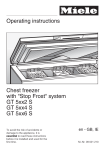
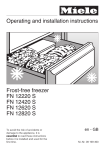
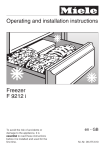
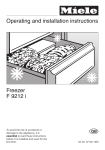
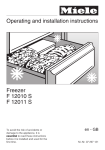
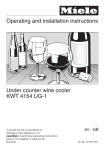
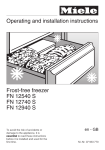

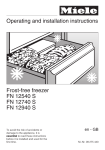
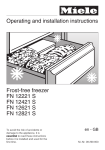
![1. Premere il pulsante [MENU]](http://vs1.manualzilla.com/store/data/006160355_1-84306467de96d71d0a469ba2a2484eac-150x150.png)
